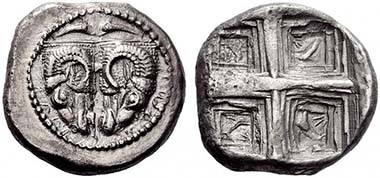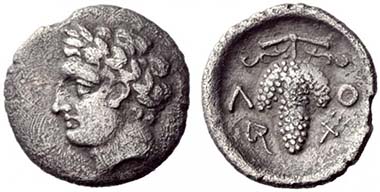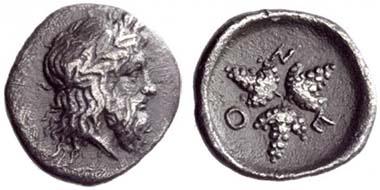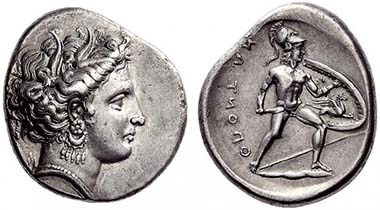07-10-2010 – 07-10-2010
Sale 55 BCD Collection of Lokris and Phokis
Post-sale comments by the collector
October 28th, 2010 – There are different ways that this subject can be approached, but it must be born in mind that it will always be from the personal view of the collector whose coins were offered for sale. Leaving aside the emotional part – “how does a collector feel when parting with his coins”, the scholarly/collector angle – “the satisfaction derived from numismatic discoveries”, or the aesthetic part – “a nice looking, hardbound catalogue designed and printed to the collector’s specifications and standards”, it was thought best to concentrate on the aspect that most collectors and dealers put on the top of their priorities: Coin prices.
376 – Phokis, Federal Coinage / Delphi, Tridrachm, 485-475. NAC 55 (2010), 376. Estimate: 150.000 CHF / Hammer Price: 475.000 CHF.
For someone who has been collecting narrowly focused areas of the Greek world for over 40 years, a general view of the art market with its immediate and obvious conclusions can only confirm today’s common knowledge: Quality is King.
However, there is a clear trend, at least during the last few decades, to seek quality without discrimination. This can only be attributed to the fact that the vast majority of collectors who can spend serious money for their hobby have limited time available to work with and study their acquisitions.
88 – Locri Opuntii, Obol, 340 BC. NAC 55 (2010), 88.
A narrowly specialized collection such as NAC 55 has, by its nature alone, the obligation to go against this trend. The collector, whether he wants it or not, has to become more or less an expert in the areas covered. This includes the important advantage of knowing in depth the relative rarity of the various coin types and denominations that were issued in the areas that he collects. Other parameters also become apparent. For instance, the note below lot 88 in the catalogue said that this coin is very difficult to acquire in undamaged condition due to its very thin flan and spread fabric. At least two buyers noticed this and took the hammer price from the opening bid of CHF 400 all the way up to CHF 3000.
One more such coin was included in lot 458, towards the end of the sale, in the multiple lots put together especially for dealers. Its quality was almost the same but the photograph was not enlarged and no attention was drawn to it. The dealer who bought that lot for CHF 6000, up from an estimate of CHF 1000 and an opening bid of CHF 3000, surely got a bargain as the six remaining coins in the lot outweigh by far the value of this little obol. The question remains though: why no other dealer detected this anomaly (or bargain) and bid higher for this lot? This brings us to the next observation that is of importance: The “shallowness” of the market. One could say that it is quite normal for a specialized area or subject to have only a small number of customers and it is difficult to disagree with this premise. It is a shallow market nevertheless that generates bargains for the astute buyer.
52 – Locris Opuntii, Tritetartemorion, 350 BC. NAC 55 (2010), 52.
There are a few other examples in the catalogue where prices were unexpectedly high. Leaving alone the “star” or “high powered” coins such as lots 376 and 387 that were expected to go through the roof anyway, lots 52 and 56 were two fractions that were hotly contested. The first started at CHF 2000 on an estimate of CHF 1500 and went all the way up to CHF 16000. The second, a charming miniature weighing only 0.17 g., started at CHF 480 (below the estimate of CHF 600) and was sold for CHF 4000. Both were the second known for their types.
Generally speaking the bronzes did quite well and most of the attractive fractions found eager buyers. It should however be noted that there were some bargains to be had. The following is a selection from the coins that sold below the price they fetched in past auctions:
71 – Locris Opuntii, Stater, ca. 340 BC. NAC 55 (2010), 71.
Lot 71, a rare variety of an Opuntian stater, was knocked down at CHF 4750. A year ago it realized $ 9000 in a CNG mail bid sale. It was a variety missing from the almost complete set of Opuntii staters in the BCD collection and the difference between the above amounts (augmented by the buying and selling percentages) was the price the collector had to pay in order to fill a gap in his series.
Lot 95, an attractive Opuntii hemidrachm, sold for CHF 1300. In December 1983 it was bought in a Vinchon auction for 14000 French francs. At the time there were about four French francs to the Swiss franc.
Lot 98, another Opuntii hemidrachm with a nice pedigree, sold for CHF 2800. Thirty-seven years ago it was acquired in Zurich at Sotheby’s Ward sale for CHF 3200.
Lot 224, a Phokis hemidrachm of fine style, sold for CHF 1800, below its estimate of CHF 2000. In May 1983 it was bought at a Leu auction for a hammer price of CHF 5500.
Lot 239, a Phokis obol, just managed to find a buyer at the starting price of CHF 80, below its estimate of CHF 100. Thirty-four years ago it was acquired in Victor England’s Buy or Bid sale for $ 165.
Lot 254, a superb Phokis hemidrachm, attractively toned, was knocked down at CHF 7000. Twenty-eight years ago it was acquired in a Leu auction for CHF 12000.
Lot 309, a perfectly centred Phokis hemidrachm of the time of the Third Sacred War, fetched CHF 3200. On May 1983 it sold in a Leu sale for CHF 7000.
Being physically present at an auction and getting the feeling of its atmosphere after having done your homework with the catalogue will always produce opportunities for purchases at advantageous prices. Telephone and Internet bidders are at a disadvantage as they cannot “catch the right coin at the right time and at the right price”.
From the collector / seller point of view, keeping the estimates low, well below the actual market value, is guaranteed to generate spirited bidding. Whether, at the end of the day, the collector will recoup his expenses is another matter. But as Kavafy said in his most famous poem, Ithaka gave you the wonderful trip. Creating this catalogue was an experience not to be missed. Price considerations come a very distant second to this collector’s priorities.







